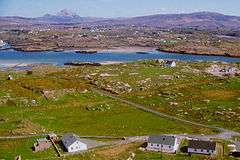The Rosses
The Rosses (officially known by its Irish language name, Na Rosa;[1] in the genitive case Na Rosann) is a geographical and social region in the west of County Donegal, Ireland, with a population of over 7,000 centred on the town of Dungloe, which acts as the educational, shopping and civil centre for the area. Defined by physical boundaries in the form of rivers, as well as history and language use, the area has a distinctive identity, separate from the rest of Donegal. The extensive region lies between the parish of Gweedore to the north and the town of Glenties to the south. A large part of the Rosses is in the Gaeltacht, which means that Irish is the spoken language. The Rosses, Cloughaneely and Gweedore, known locally as "the three parishes" with 16,000 Irish speakers, together form a social and cultural region different from the rest of the county, with Gweedore serving as the main centre for socialising and industry.[2][3] Gaeltacht an Láir is another Irish-speaking area.
Irish language
The following is a list of electoral divisions in the area:
- An Clochan Liath (1,785) (15%)
- Anagaire (2,138) (55%)
- Arainn Mhor (529) (62%)
- Inis Mhic an Doirn (1,410) (9%)
- An Duchoraidh (78) (34%)
- Leitir Mhic an Bhaird (650) (19%)
- An Machaire (615) (15%)
- Cro Bheithe (170) (60%)
Culture

Once a predominantly Irish-speaking area, over recent generations English has become increasingly common. Irish is still used extensively in some areas including parts of the island of Arranmore, the townland of Ranafast and the village of Annagry. In some areas, like the hills around Dungloe, around Loughanure and in pockets of Doochary and Lettermacaward, the Irish language is predominant.
The local people are said to have a preference for Gaelic football over soccer, which is often the case in rural areas of the country. The area fields a number of football teams, both in soccer and Gaelic football. Keadue Rovers from the lower Rosses have traditionally been the area's strongest soccer team, whereas Dungloe have been the strongest in Gaelic football. There is also a strong tradition of songwriting in the area, Seán McBride (1906–1996) from Cruit Island wrote the popular song "The Homes of Donegal".
There are connections between the people of The Rosses and Scotland, Glasgow in particular, due to the economic need for emigration in the past and the strong ties forged over the generations as a result. Many people from The Rosses, in common with people from other parts of County Donegal, have also settled in the City of Derry, especially since the late 1840s.

Geography
The area is bounded by the River Gweebarra to the south, the Gweedore River to the north, the Derryveagh Mountains and the Gweebarra River (Doochary Bridge) to the east and the Atlantic Ocean to the west. The name comes from "Ros", the Irish word for headland. The area presents a rocky barren landscape, studded with a myriad of lakes and inlets of the sea.

Transport
The Rosses boasts Donegal's only airport at Carrickfinn. Various coach companies serve the area.
History
The Rosses has been inhabited since time immemorial, and the ancient church of St. Crona in Termon near Dungloe has been dated to the 6th century AD. It was the site of a monastery founded by St. Crona, a cousin of the Royal Saint Columcille, founder of the monastic settlement at Iona, and was the centre of the parish of Templecrone.

In the 16th century, a number of ships from the Spanish Armada sank off or landed off its coast.
Economy
Historically The Rosses has relied heavily on hospitality, tourism and the fishing industry as the mainstays of its economy. The area has its own indigenous supermarket chain called The Cope which has been quite successful. There is very little manufacturing industry in The Rosses apart from a few companies located in Dungloe.
Tourism
The area claims a large proportion of Donegal's tourist income, due to its renowned scenery[4] and its many festivals, including the Mary From Dungloe International Festival. There is a very strong tradition of marching bands emanating from the region; the area boasts many All-Ireland championship bands in all grades and disciplines.[5][6]
Notable people from the Rosses
- Packie Bonner, former Ireland goalkeeper
- Goats Don't Shave, folk band
- Niall Ó Dónaill, lexicographer
- Daniel O'Donnell, singer
- Peadar O'Donnell, socialist and author
- Pat the Cope Gallagher, MEP
- Margo, singer
- Séamus Ó Grianna, author
- Seosamh Mac Grianna, author
- Skara Brae, folk band
Townlands in the Rosses
- Annagry (Anagaire)
- Braade (An Bhráid)
- Burtonport (Ailt an Chorráin)
- Carrickfinn (Carraig Fhinne or Carraig Fhinn)
- Crolly (Croithlí)(half of which is situated in Gweedore)
- Doochary (An Dúchoraidh)
- Dungloe (An Clochán Liath)
- Keadue (Céideadh)
- Kincasslagh (Cionn Caslach)
- Lettermacaward/Leitir (Leitir Mhic an Bhaird)
- Loughanure (Loch an Iúir)
- Maghery (An Mhachaire)
- Meenbanad (Meenbanad )
- Mullaghduff (Mullach Dubh)
- Ranafast (Rann na Feirste)
- Roshine
Islands
- Arranmore (Árainn Mhór)
- Cruit (An Chruit)
- Iniscaoragh (Inis Caorach)
- Inisfree (Inis Fraoigh)
- Owey Island (Oileán Uaighe)
See also
County Galway
County Donegal
County Kerry
County Mayo
External links
References
- ↑ Placenames (Ceantair Ghaeltachta) Order 2004
- ↑ http://www.donegaldemocrat.ie/news/cloughaneely_1_1986720
- ↑ http://www.letterkennypost.com/2007/05/page/2/
- ↑ http://www.donegalgameanglers.com/home/index.php?id=73
- ↑ http://www.nwipp-newspapers.com/DN/free/305192561911347.php
- ↑ http://www.burtonport.net/Page3.html
Coordinates: 54°59′04″N 8°24′33″W / 54.98444°N 8.40917°W
